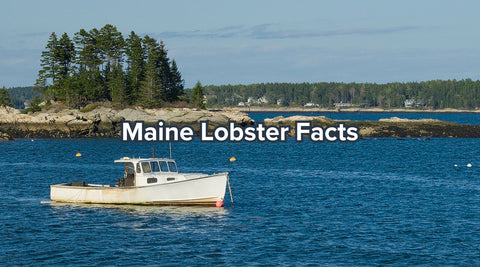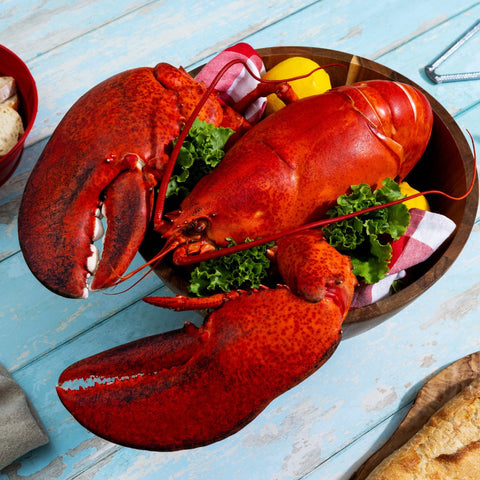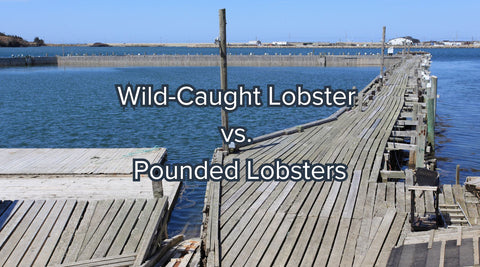24 Fascinating Lobster Facts
Everyone agrees that Maine lobster is delicious — from freshly steamed lobster with melted butter to traditional Maine style lobster rolls. Lobster is now seen as a delicacy across the country, but it took a long time for this delectable crustacean to make its way to your dinner plate. And, while you may have mastered the best way to crack open a lobster claw, you may not know very much about the fascinating anatomy of lobsters or what they do all day at the bottom of the ocean. For some seafood enlightenment, we have compiled 24 interesting facts about the anatomy, lifestyle and history of lobsters. These fascinating lobster facts will help you appreciate these delicacies, even more, the next time you take a bite.

The Awesome Anatomy of Lobsters
Lobsters are easily recognizable by their long insect-like bodies and large claws, but there is a lot more to the anatomy of a lobster that you probably didn't know.
1. Two Strong Front Claws
The first thing to know about Maine lobsters and what visually distinguishes them from other types of lobsters is that they have two strong front claws. All lobsters have eight walking legs they use to crawl forward.
2. Wild Lobsters Are Colorful
While we commonly imagine the iconic bright red lobster, lobsters in nature are a wide range of colors, but not red. Wild lobsters can be green, blue, yellow, grey, calico, multi-colored or even albino. Most commonly, lobsters are a dark greenish-brown, and the more unique colors are the result of a genetic mutation that causes a color of pigment to be missing. When a lobster is cooked, only the red pigments in the shell can withstand the heat, resulting in the bright red shell most people are familiar with. Only albino, or white, lobsters retain their natural color after they are cooked because their shell does not contain any color pigments.

3. Lobsters Have Clear Blood
Unlike humans and other mammals whose blood is red, lobsters have clear blood. When cooked, their blood oozes out of the lobster meat, producing a thick opaque white substance. You can see this jelly-like substance along the inside of the shell when you crack it open.
4. Lobsters Have a Dominant Claw
Each lobster has two different claws, a larger crusher claw and a smaller pincher claw. The crusher claw has a ridged edge that resembles molars and is used to break up hard food such as clams and crabs. The pincher claw, or ripper claw, is used to tear apart softer prey such as worms or fish. These claws can be on different sides of a lobster's body, as the crusher claw is always on the lobster's dominant side.

5. Lobsters Can Regenerate Their Limbs
If a lobster loses a claw, antenna or leg, it is able to grow it back. However, it typically takes about five years for a lobster to regenerate a claw that is the same size as the one it lost. Lobsters that are missing a claw are referred to in the industry as "cull." Cull can still be caught and consumed, and are often marked down in stores. However, if you are serving lobster a fancy dinner party, you may want to wait for its limbs to grow back.
6. Lobsters Smell With Their Legs
Lobsters use small chemosensory hairs on their legs and feet to identify their food. This is particularly useful for small creatures or food that is dissolved into the water. Lobsters also use the antennae on the front of their heads to smell food that is further away. Combined, these features make their sense of smell so precise that they can seek out a single amino acid just by smelling. When consuming their prey, the hairs on a lobster's front walking legs allow them to taste the food.
7. Lobsters Have Poor Vision
Members of the lobster species have poor vision. They probably don’t see objects but can detect motion in dim light in the depths of the sea. They may be blind in bright light.
Lobsters use their excellent sense of smell to locate their prey. Their longer antennae and tiny hairs over their whole body are sensitive to touch. The shorter antennae detect odors and chemical signals in water. Those shorter antennae also help lobsters to find their food.
8. Lobsters Chew With Their Stomachs
Lobsters do not have teeth, but instead have a structure called a gastric mill that is located in their digestive track. The gastric mill has three grinding surfaces that break down food as it moves from the lobster's mouth to its stomach. A lobster's stomach is located right behind their eyes and is about the size of a walnut.
9. Lobsters Grow by Molting
A lobster's shell does not grow, so they must molt their shell and grow a new one as they age. When lobsters molt, they wiggle out of their hard exoskeleton, leaving them vulnerable to predators. The molting process itself puts a lot of stress on a lobster's body, and about ten to fifteen percent of lobsters die naturally while shedding their shell. As the lobster grows, each new molting requires even more energy. Lobsters molt very frequently in the first few years of their life, and then about once a year after they have reached a mature size. Typically, lobsters molt about 25 times in the first five to seven years of their life. After lobsters molt, they are starving and deficient in nutrients, so they often eat the shell they have just molted to replenish their calcium levels.

A Day in the Life of a Lobster
Ever wonder what lobsters do all day at the bottom of the ocean? Read on for some insight into the lifestyle of Maine lobsters.

10. Lobsters Live on the Ocean Floor
Smaller lobsters typically live in rocky habitats or seaweed where they can find protection and food. Larger lobsters may explore further offshore in coastal habitats. Most lobsters do not migrate, and will only travel about a mile. Some larger lobsters that live in deeper waters are known to migrate closer to the shore in summer.
11. Lobsters Can Swim Backward
While lobsters most commonly swim or crawl forwards, they can swim backward just as easily. If a lobster feels threatened or startled, it will dart backward by curling and uncurling its tail. This allows it to keep its eyes on the predator or threat in front of it while escaping.
12. Lobsters Cannot Process Pain
Before dropping a lobster into a pot for the first time, many people find themselves wondering, "Do lobsters feel pain?" While it is impossible to come to a completely conclusive answer to this question, most scientists would agree that lobsters are not able to process pain. Lobsters do not have a cerebral cortex, which is what gives humans our perception of pain, so it is unlikely that lobsters can feel pain. The hissing noise that occurs when a lobster is boiled can often be mistaken for crying or screaming but is just steam escaping from the lobster's shell.
13. Lobsters Are Cannibalistic
Lobsters typically dine on fresh food such as clams, crabs, snails, mussels, sea urchins and small fish. However, when these food sources are not available or are scarce, they will also eat other lobsters. Other lobsters are the biggest threat just after a lobster has molted when it is an easy target for all predators, including other hungry lobsters.

14. Lobsters Have a Fascinating Reproductive Process
Lobsters are only able to breed seasonally, right after the female lobster has molted. Once she sheds her hard shell, she releases a pheromone to attract male lobsters for breeding. This has the bonus of protecting her from being eaten by other lobsters before her new shell has grown because male lobsters would rather mate with her than eat her. Once the female lobster has mated, she can carry the sperm in her body and choose when she wants to fertilize her eggs. If the water is warm and conditions are fair, she can hold the sperm for up to a year. Female lobsters can produce more than eight thousand eggs which may be fertilized by several different males. Lobster eggs are carried under the female's body in her swimmerets until they hatch nine to twelve months later.
15. Lobsters Never Stop Growing
As far as scientists know, lobsters continue to grow throughout their entire lives. Lobsters will continue to eat, grow and molt indefinitely until they die of natural causes or are caught. The largest lobster recorded so far was caught in Nova Scotia in 1977. The monstrous lobster was 3.5 feet long and weighed over 44 pounds. Since then, many Maine lobsters weighing nearly thirty pounds have been pulled out of the Atlantic Ocean. Theoretically, there could be massive lobsters living in the deeper ocean that we simply have not yet discovered.

16. Lobsters Are Biologically Immortal
As lobsters get older, they show no signs of aging. Older lobsters continue to eat, have a stable metabolism and have high energy. Lobsters also continue to mate and reproduce with equal vigor. In fact, older and larger female lobsters can carry more eggs than younger, smaller lobsters. This has caused scientists and lobster-lovers alike to ask, "Are lobsters immortal?" Because lobsters do not show characteristics of aging, or senescence, they are said to be biologically immortal. Most lobsters die from external causes, including predators, humans and disease, but it is still possible for a lobster to die from old age. This typically occurs when an aging lobster is unable to continue molting and rots inside of its shell.

17. Lobsters Can Live to Be Over 100 Years Old
Scientists do not have a method to accurately determine the age of a lobster. When lobsters molt, they also shed their gastric mill and digestive tract along with their shell. This means that no hard parts are left for scientists to sample to determine age. However, scientists can estimate the age of a lobster based on its size. Lobsters purchased in stores are typically about five to seven years old, but scientists estimate that lobsters can live to be over one hundred years old.
The Long History of the Lobster Industry
From slave food to delicacy, lobster has traveled a long way to make it to our dinner plates today. Read on for some fascinating history about how lobster became a delectable food fit for kings.
18. The First Lobster Catch Was Over 400 Years Ago
The first Maine lobster catch was recorded by James Rosier in 1605, but the lobster industry truly took off in the 1700s when lobster "smacks" were introduced. These traditional fishing boats continued to be used by lobstermen in the Northern Atlantic through the 1900s.
19. Lobster Was Once Poor Man's Food
When lobster was first consumed, it was by servants and prisoners. Lobster was plentiful in oceans around New England, making it an extremely cheap food source. In fact, servants and slaves were forced to eat lobster so often, that prisoners in a town in Massachusetts fought to have a rule passed so they only had to eat lobster three times a week. Extra lobster was fed to pigs or used as fishing bait or fertilizer.
20. Lobster Used to Be Caught by Hand
Because lobster was so plentiful, they would wash up on the seashore in large piles after storms. Lobsters were then gathered by hand from tide pools and beaches. Lobster fishing and trapping did not develop until much later.

21. Egg-Bearing Lobsters Are Legally Protected
After the creation of smacks and trap fishing, the number of lobsters in the ocean began to decline. Lobster also became popular as a canned good in the mid-1800s, leading to a rapid decrease in population. In 1872, the first law was passed in Maine to ban the capture of egg-bearing females. This conservation is still in place, and lobster-fishers are required to cut a small v-shaped notch in the tail of an egg-bearing female lobster so other fishers can identify it. Female lobsters with a v-notch are illegal to catch and consume. These conservation methods have helped lobster populations grow again, so we can continue to enjoy this delicacy.
22. Lobsters Can Be Purchased Soft-Shell
While many people associate soft-shell with crabs, lobsters can also be purchased with soft shells. Soft-shell lobsters are caught just after molting, typically in July and October. While not as common as hard shell lobsters, soft-shell lobster is said to have sweeter and more tender meat.
23. Lobster Meat Is Healthy
In addition to its rich and delicious taste, lobster is good for you too. Lobster is high in protein and low in fat. Three ounces of lobster contains about 76 calories, 16 grams of protein and less than one gram of fat. Lobster also contains healthy omega-3 fatty acids and iron. If you avoid smothering it in butter, lobster is a great addition to any diet and a healthy way to build muscle. When shopping for lobster, seek wild caught lobster that was not raised on a farm. Farm-raised lobster often contains antibiotics or hormones that many people want to avoid.

24. Maine Lobster Is the Best Lobster
While we may be a little biased on this "fact," Maine's massive lobster industry attests to the quality of our catch. Lobster represents 75 percent of Maine's commercial fishery value and hauls in hundreds of millions of dollars each year. The largest catch on record occurred in 2016 when Maine's 6,000 lobster-fishers landed more than 130 million pounds of lobster. This massive catch was valued at over $533 million. Maine lobster is iconic, not only for its economic value but also for its delicious meat. While spiny lobsters caught in the southern Atlantic and Caribbean are only eaten for their tails, Main lobsters boast large meaty claws as well as delicate and delicious tails. Some people will even crack into the delicate legs of Maine lobsters to enjoy every last bite of tender meat. Over the last 400 years, Maine's long history of lobstering has shaped both the culture and cuisine of the state and thrilled taste buds across the country.
Fresh Maine Lobsters From Maine Lobster Now
Now that your mind is blown and your mouth is watering, it's time to cook up some fresh Maine lobster. No matter where you live, Maine Lobster Now can provide fresh, live lobster that is caught in the Atlantic Ocean. Our wild lobsters are never raised with hormones or antibiotics so you can rely on genuine and natural taste. When you order a lobster from Maine Lobster Now, we ship your live lobster overnight to ensure freshness and quality. Experience Maine from the comfort of your home or bring elegance to your dinner party with freshly cooked whole lobster. If whole lobster doesn't suit your style, choose from our large selection of lobster products and other seafood. From lobster tails to delicious Maine lobster rolls, Maine Lobster Now provides the highest quality seafood caught fresh from the Atlantic Ocean and shipped right to your door.




